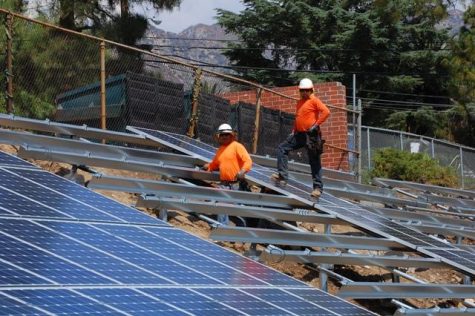Solar Panels Light Clark’s Future
 Following several months of construction, solar panels in the student and teacher parking lots and the field have finally come to fruition, generating energy throughout the school and providing shade for the majority of the cars. Several Glendale Unified School District schools – others being Crescenta Valley High School, Rosemont Middle School, Columbus Elementary, and Keppel Elementary – have benefitted from Measure S, a school bond approved in April 2011.
Following several months of construction, solar panels in the student and teacher parking lots and the field have finally come to fruition, generating energy throughout the school and providing shade for the majority of the cars. Several Glendale Unified School District schools – others being Crescenta Valley High School, Rosemont Middle School, Columbus Elementary, and Keppel Elementary – have benefitted from Measure S, a school bond approved in April 2011.
Measure S has allowed GUSD to borrow $270 million in bonds, five percent of which has gone to technological advances for the district, such as the solar projects. The passing of the bond funds a renewable source of money spent on energy. Yingli Solar, also known as Yingli Green Energy Holding Company Limited, The schools to have the panels placed were chosen based on their topography – due to their exposure to sunlight and potential for generating energy. Since the addition of the solar panel construction in May, according to Principal Doug Dall, the district has reduced its money spent on electricity.
“Seventy percent of Clark’s power will comesfrom panels,” says Dall. “The energy produced goes to anything in the school that produces power.” As a school focused on technology consuming a large amount of power, Dall says that over the past three to four years, the administration has been making efforts to reduce the amount of power used, even before the solar panels were placed. Some of these changes include the mission of no longer having 130 watt-cathode ray computer monitors on the campus.
Now, computers use low energy monitors that consume only 30 watts, which also produce less heat and require less air conditioning. Beyond computers, the school has undertaken other forms of energy savings. “Notice that when you walk through the halls, there are only two lamps inside the lights rather than four,” Dall said. “Conservation in a cumulative effect.” As an intended long term benefit, the solar project could potentially benefit not only current students, but also those in decades to come. “The solar panels should last thirty years,” says Dall, “so if you think about it, by that time your kids would be attending a school that is still being powered by the energy produced by the panels.” “It’s not just the future,” says Dall, “It’s here now.”



